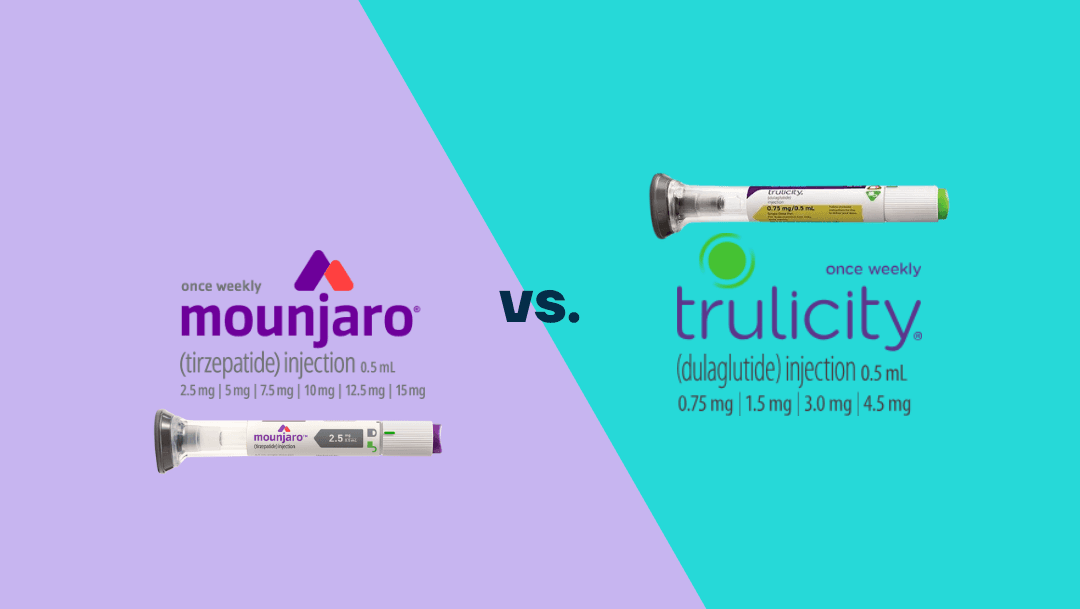Jump to: How do Mounjaro and Trulicity work? | Mounjaro vs. Trulicity: Which is better for weight loss? | Mounjaro vs. Trulicity: Which is better? | Take home message
Mounjaro and Trulicity are medications approved for the treatment of individuals living with type 2 diabetes in the UK.
Trulicity and Mounjaro are manufactured by the pharmaceutical company Eli Lilly. The active ingredient in Mounjaro is tirzepatide, and dulaglutide in Trulicity.
Mounjaro and Trulicity are GLP-1 receptor agonists, medications that reduce appetite to support weight loss and improve blood glucose control through various mechanisms.
Mounjaro – in addition to being a GLP-1 medication – is also a glucose-dependent insulinotropic polypeptide (GIP) mimetic.
So, Mounjaro has a dual function that mimics two hormones in the body that support blood glucose levels and weight loss.
According to data from randomised controlled trials, Mounjaro is generally more effective than Trulicity for weight loss and blood sugar improvements.
So, if you’re looking for a medication to help you lose weight and improve your blood sugar levels, Mounjaro will lead to more weight loss and blood sugar reductions.
However, individual responses to medications vary between individuals. Be mindful of side effects and contact your healthcare team to determine the appropriate medication and dosage.
Trulicity is available in the UK on prescription, while Mounjaro is likely to be available in early 2024 after being approved for type 2 diabetes in September 2023 and obesity in November 2023.
Both medications have similar dosing schedules and are administered once a week. The main difference is the amount of medication used. The volume of the doses with Mounjaro is larger than with Trulicity.
Moujaro and Trulicity dosing schedules:

Not a magic pill
Weight-loss injections are designed as additional tools for healthy lifestyle change and shouldn’t be considered as lifelong medications.
Instead, they should be used to help you kickstart your weight-loss journey whilst you focus on building new, healthy habits.
Consider the use of antidepressants for people living with depression. They’re not designed to cure the condition. Instead, they’re designed to allow room for therapy to treat the condition’s underlying cause.
Mounjaro and Wegovy are similar. These medications can help silence food-related thoughts and also give you a boost of confidence with more immediate weight-loss results.
This helps to buy you the time and headspace to understand why your body may have struggled to lose weight previously, and to build new long-term healthy habits.
The core focus of our medication programmes are to calm down the feeling of food noise, lower your cravings, and to allow you to build healthier habits to keep the weight off for good.
The ultimate goal is to make losing weight feel second nature.
Second Nature’s medication programme
Second Nature currently provides Mounjaro as part of our Mounjaro weight-loss programme.
Why should you choose Second Nature over other medication providers if you’ve decided to try Mounjaro (assuming you’re eligible)?
For peace of mind.
Second Nature has worked with the NHS for over 6 years providing weight-loss programmes across the UK.
While our Mounjaro weight-loss programme is private and not currently used by the NHS, we’ve built the programmes focusing on scientific evidence, patient safety, and data security.
We hope that our 6+ years of working with the NHS and building a track record of effective weight-loss results will give you peace of mind to give us a try.
Otherwise, keep reading as examine the science of Mounjaro and Trulicity.
1) How do Mounjaro and Trulicity work?
When we eat food, our gut releases hormones that help the body regulate hunger and blood sugar levels.
GLP-1 (glucagon-like peptide-1) and GIP (glucose-dependent insulinotropic polypeptide) are two of these hormones.
GLP-1 improves insulin function to lower blood sugar levels and delays gastric emptying, decreasing appetite.
GLP-1 also communicate with the brain’s appetite control centre, the hypothalamus, to lower hunger and food-seeking behaviour.
Trulicity and Mounjaro mimic the actions of the hormone GLP-1 and are known as GLP-1 receptor agonists or GLP-1s.
GIP is a hormone also released in response to food that helps to regulate blood sugar levels and helps our fat cells ‘absorb’ more excess energy, which prevents fat from being stored in the liver or pancreas.
GIP also communicates with the brain and is believed to lower hunger and food-seeking behaviour, similar to GLP-1.
Mounjaro, in addition to its function of mimicking GLP-1, also mimics the actions of GIP and is a dual-action type 2 diabetes and weight-loss injection. Trulicity, in comparison, is a single-action type 2 diabetes injection.
Key points:
- GLP-1 receptor agonists (GLP-1s) are a class of medications that mimic the actions of the hormone GLP-1, which helps regulate hunger and blood sugar levels
- GLP-1s help the pancreas release more insulin, delay stomach emptying, and reduce appetite
- GIP mimetics mimic the action of the hormone GIP, which improves insulin secretion to lower blood glucose and helps the body store fat in the adipose tissue, protecting the internal organs from excess energy storage
- Trulicity is a single-action medication and mimics the hormone GLP-1
- Mounjaro is a dual-action medication and mimics the hormones GLP-1 and GIP
2) Mounjaro vs Trulicity: Which is better for weight loss?
Mounjaro (tirzepatide) leads to more significant weight loss than Trulicity (dulaglutide).
However, it’s worth noting that Trulicity isn’t approved for weight loss in the UK but only for people living with type 2 diabetes.
A randomised controlled trial in 636 adults compared the impact of Mounjaro to Trulicity on weight loss and blood sugar after one year.
The results showed that all three doses of Mounjaro (5mg, 10mg, and 15mg) led to more significant weight loss than Trulicity.
Participants on 5mg of Mounjaro lost 7.8% of their weight, those on 10mg lost 11%, and those on 15mg lost 13.9%. In comparison, participants on Trulicity lost less than 1% of their body weight on average.
Other trials on Trulicity have shown similar results on weight loss of around 1-2%.
Mounjaro vs Trulicity: Which is better for HbA1c?
The study in 636 participants mentioned above also measured the impact of Mounjaro and Trulicty on blood sugar improvements, or HbA1c, a test that measures average blood sugar (or blood glucose) levels over the past 90 days or so.
All three doses of Mounjaro were more than twice as effective at lowering HbA1c than Trulicity after one year.
So, Mounjaro is a more effective medication than Trulicity for supporting weight loss and blood sugar improvement.
Key points:
- The highest dose of Mounjaro leads to a weight loss of around 13% after one year, whereas Trulicity has a minimal impact on weight loss, and patients average around 1% of weight loss
- The three doses of Mounjaro are all around twice as effective at lowering HbA1c (blood sugar) than Trulicity
- Mounjaro is a more effective type 2 diabetes and weight-loss injection than Trulicity
3) Mounjaro vs. Trulicity: Which is better?
Effectiveness
Mounjaro is a more effective drug than Trulicity. As demonstrated above, tirzepatide (the active ingredient in Mounjaro) leads to more clinically significant weight loss and blood sugar reductions than dulaglutide (the active ingredient in Trulicity).
If you were looking at trying GLP-1 medications for weight loss or blood sugar improvements, Mounjaro would be the better choice.
However, the drugs differ in their side effects and safety profile, which might influence your decision.
Side effects and safety
All medications have possible side effects, particularly if you live with other health conditions.
Some will be mild but uncomfortable, such as cramping, and others will be more severe, such as shortness of breath. You must report any side effects you experience to your doctor and healthcare team when on medications.
A study comparing Mounjaro to Trulicity found that nausea was the most common side effect of both medications.
However, only 8% of participants on Trulicity reported nausea compared to 12% on Mounjaro 5mg and 20% on Mounjaro 10mg and 15mg.
Other side effects including constipation were reported at similar rates in the Mounjaro and Trulicity participants.
Cost
Mounjaro
Mounjaro will cost around £200-£300 a month from Second Nature when it becomes available. This price includes 1-1 support from a registered nutritionist to help you keep the weight off for good.
Getting Mounjaro on prescription through the NHS will cost the standard prescription fee of £9.95 in England.
Trulicity
The cost depends on where you’re purchasing it from and how long you intend to use the medication. However, to purchase the medication and injectable pens required for four weeks would cost around £126, or around £1520 per year.
Getting Trulicity on prescription through the NHS will only cost you the prescription fee of £9.95 in England.
Key points:
- Mounjaro is more effective than Trulicity at supporting weight loss and blood sugar reductions
- However, Trulicity may lead to less feelings of nausea than Mounjaro. Overall, the safety profile of both medications is similar, and the most common side effects are GI-related, like constipation.
- However, individuals will vary in their medication response, so choose the right one for you
- Trulicity is currently available in the UK
- Mounjaro has been approved in the UK, but it’s not yet widely available
- Both medications are expensive if you opt to purchase them privately
Take home message
The recent innovations in GLP-1 medications are pretty remarkable and have caused quite a stir in the world of healthcare.
We’re in new territory where obesity and type 2 diabetes medications treat an underlying cause instead of merely treating the symptoms to support better management.
However, these drugs shouldn’t be seen as miracle cures; they’re not designed to be used for life.
They’ve been designed to be taken alongside lifestyle changes that will enable you to eventually come off the medications and maintain your lower weight for the long term.
GLP-1s are safe and effective for most people in the short to medium term, but we don’t have long-term data to be sure they’re not causing severe adverse effects elsewhere.
At Second Nature, we’re not against using medications to support people in making healthy changes and reducing their risk of chronic disease.
However, we don’t recommend using medications as a reason not to make healthy lifestyle changes. The causes of obesity and type 2 diabetes aren’t merely rooted in biology but also psychology and sociology.
With these medications, you may lose weight and reduce blood sugar levels. But will you be happier? Will you be more fulfilled? Will you be content with your life and social relationships?
For that, you may need to consider a lifestyle change.





